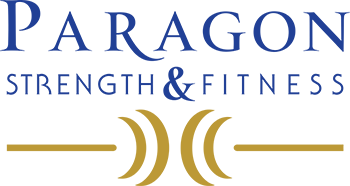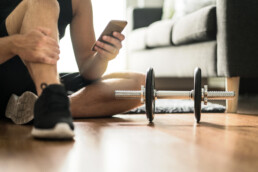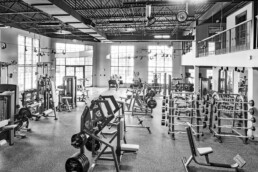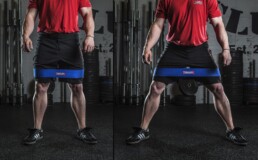The Importance of Unilateral Development
What is Unilateral or Bilateral Movement in Sport
Most sports training programs focus on bilateral movements. When defined, bilateral means having or relating to two sides; affecting both sides. When put into sport-specific training terms, think of your major compound lifts: The bench, squat, deadlift, power clean, etc. When defined, unilateral means relating to, occurring on, or affecting only one side of an organ or structure, or of the body. When this is put into a sport-specific training we think of single-leg squats, lunges, split squats, step-ups, etc. There are studies that show unilateral and bilateral training lead to similar effects in terms of strength, sprint speed, and change of direction speed. For example, 18 rugby players spent 5 weeks training their legs with either single-leg or both-leg squats. (1) Both groups saw similar improvements in their agility, strength, and coordination. While differences may not be significantly apparent across a group, injury risk, field performance, and the normalization of data are very difficult to account for.
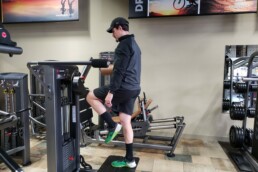
A step-up is a common movement used to test single-leg stability, knee tracking and strength discrepancies.
What should we focus on more?
Athletes need to be well rounded. They need to be strong, yet agile. They need to be explosive, yet stable. This is achieved by training both bilateral and unilateral movements. Clients that follow our athletic performance training protocols will focus on increasing both in any given session. A 2016 Study(2) shows that unilateral training over a given training cycle may not see massive increases in bilateral strength, but will notice improvements in those specific unilateral movements. While this may seem like a waste of time if you aren’t gaining overall strength, there are several factors to consider that prove unilateral development is incredibly useful in training:
1. Unilateral Movements are More Common In Sport
Athletes should train squats, deadlifts, power cleans and similar bilateral movements to increase their overall strength and power. But, in any given sports training program, unilateral movements are king. Running, jumping, pivoting, kicking, punching and changing directions are just a small sample of movements athletes perform in any given sport. Athletes need to have the ability to be powerful, but light on their feet. At Paragon, our favorite unilateral movements are weighted step-ups, single-leg broad jumps, single-leg squats, single-arm overhead presses with an overhead carry and single-arm dumbbell bench press to name a few. We preach form and control over anything heavy with these movements. The goal is to mimic the bilateral movement, just unilaterally. This means proper knee, elbow, and core positions in any given movement, regardless if our athletes are using one or two body parts.
Sprinting relies heavily on single-leg explosive power.
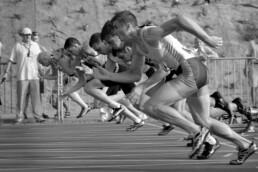
2. Unilateral Training Can Correct Muscular Discrepancies
Most athletes create some sort of imbalance due to their sport. It’s easy to see and easy to test. Sports place a greater strain on one side of the body due to using a preferred leg or arm to kick, jump, run or throw. Most athletes will jump off of one leg for a lay-up or pitch and catch a baseball with the same arm each time. Instead of wishing every athlete could be ambidextrous, we can have every athlete train their unilateral movements. Not only will single-arm or single-leg training increase the strength on the weak side (as shown in the above studies), but it can correct the posture and form of the dominant side.
Everyone has a stronger side even if you don’t play a sport. Ask anyone you know what arm or leg is stronger and they know almost immediately. That strength gap may never fully close, but the goal of unilateral movement is to at least work on creating closer comparisons of strength. This may not lead to overall strength gains as mentioned above, but you can certainly expect better stability in any given movement and less risk for injury as well.
The suitcase carry is an anti-rotational movement that targets your core, shoulders, back, forearms and legs on the side the movement is performed.
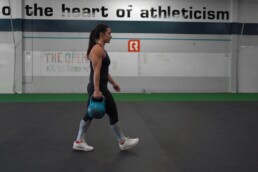
3. Unilateral Development Isn’t Just for Athletes
From one on one clients to our Paragon athletes, everyone at Paragon performs unilateral movements. From single leg glute bridges to suitcase carries, our clients perform unilateral movements in almost every session. Stability is important for everyone, regardless of age or athletic ability. Not only is unilateral strength work fun, but it is also eye-opening to many clients who had absolutely no idea one leg or arm was so much stronger than the other. It creates a desire in them to remedy the situation and gives us a common goal that we share with them.
On top of being a great training tool, unilateral development training also offers a mental “break” for our clients. If you are worn down, or you are still sore from your last workout, unilateral work offers a nice change of pace from usual bilateral movements. You can’t lift nearly the same amount of weight with one leg or arm as you can using both. This inheirantly means less overall stress on the CNS. Are you beat up from squatting? Try nice slow controlled step-ups to work your legs without putting more stress on your joints.
Get More From Your Training
Start reaping greater rewards from your training with the help of the best personal trainers in the Nashville area, who will tailor a plan just for you and your goals. Contact Paragon Strength & Fitness to start your life-changing journey today.
1. Speirs, Derrick E., Mark A. Bennett, Charlotte V. Finn, and Anthony P. Turner. “Unilateral vs. Bilateral Squat Training for Strength, Sprints, and Agility in Academy Rugby Players.” The Journal of Strength & Conditioning Research 30, no. 2 (2016): 386-392.
2. Botton, Cíntia E., Regis Radaelli, Eurico N. Wilhelm, Anderson Rech, Lee E. Brown, and Ronei S. Pinto. “Neuromuscular adaptations to unilateral vs. bilateral strength training in women.” The Journal of Strength & Conditioning Research 30, no. 7 (2016): 1924-1932.
11 Holiday Healthy Eating Guide Tips from a Personal Trainer
The holidays are a time to come together with the people you love. Your home is decorated, and of course, there are always snacks, plus enough food to feed everyone who is with you and still have leftovers. The trick that many face during this time of the year is how to celebrate without your clothes feeling a bit tighter than they should and losing the progress that you spent months working on with your diet.
It doesn’t matter if you are just trying to get ready in time for summer, or if you’re trying to increase your athletic performance, eating healthy during the holidays is important. Our holiday eating guide covers some questions answered by our trainers at Paragon Strength & Fitness to help you make sure your holidays are both happy and healthy.
Christmas is a great time to spend with family, but you don’t have to spend that time sitting around watching TV. Make plans to be active with your family. Moving daily can help keep you healthy.
1. How Can I Be Healthy at Christmas?
Be cautious around alcohol. It can be tempting to just have a few drinks, but even the calories in light beer can start to stack up fast. If you have more than your fair share of drinks a day over your holidays you can be adding hundreds, if not thousands, of calories to your diet that have no nutritional value and only require you to spend even more time working out to break even. Enjoy your drinks with your family, but keep your intake under moderation.
2. How Can I Eat Healthy Around the Holidays?
Traditional Christmas and holiday food are swimming in fat and carbohydrates. If you’re looking to eat healthy around the holidays, you might want to change your menu and shop smart. Plan your menu well before the big day, and stick to it. Don’t go to the store and grab whatever looks tasty, but be intentional with your food. When you are planning your meals, focus on produce and healthy substitutions.
3. What is Conscious Eating?
Conscious, or mindful, eating is eating slowly and without distraction. As you eat, you are aware of your physical levels of hunger and do not eat more than you need or feel comfortable with. Trust your body to tell you what to eat and when to stop. If you’re not hungry, or if your body doesn’t want a certain food, don’t eat. Listen to your body and stop when you are full. When you are eating, be in the moment and focus only on eating; don’t distract yourself with a TV show, movie, parade, or anything else that is going on.
4. How Can I Avoid Gaining Weight over the Holidays?
During the holiday season, often it’s not the mealtimes that you have to look out for, but the abundant amount of snacks. There are gingerbread houses, sugar cookies, sweets, candies, crackers, and so much more that are out on the table or countertop throughout the entire holiday free to pick up whenever you want.
Remember that you don’t have to eat just because there’s food around you. It’s best to avoid snacking altogether both before, during, and after the holiday season. Keep your workouts and workout times consistent. Most likely you’ll have some time off of work, which should free up your schedule to keep your workouts included in your daily schedule.

5. How Do You Eat Right During the Holidays?
If you’re not in charge of the food, eat small, regular meals. Don’t eat less the day of a big party and then binge at dinner. This will help you from overeating while still keeping your diet and health in mind throughout the holidays.
When you do start to eat, start simple. Filling your plate with veggies, fruit, green salads, and lean meats to start off with can help curb your appetite and keep you away from the high-calorie side dishes that you keep eyeing.
That being said, you don’t have to eat sad to eat right. You can allow yourself a taste of those delicious pies, desserts, and sides, but eat in moderation. Keep it to a small taste test. If you don’t think that a small taste will be enough, don’t even start. Know your limits and work within them.
6. How Can I Stay on Track with My Diet During the Holidays?
If you are able to manage your own food, stick to your menu and don’t have a cheat day. You have the power to control what you eat, and just because it’s the holidays doesn’t mean that you are forced into eating unhealthy.
7. How Can I Train My Brain to Eat Less?
Consider eating on a smaller plate. We tend to fill our plates, no matter what size they are. With a smaller plate, you won’t be able to fill it as much, and you’ll keep your caloric intake lower than if you had a large plate. Just make sure that you don’t go back for seconds, thirds, or fourths or else you’re just defeating the purpose of using the smaller plate.
Another trick to help you eat less is to eat a plate and wait 10 minutes after before deciding on seconds. Often times with delicious foods, we eat so fast that we skip over that “full” feeling until we are well into the “uncomfortably full” feeling.
8. How Can I Boost My Metabolism?
Your metabolic rate is the number of calories you burn. The higher it is, the more calories you burn and the easier it is to lose weight and keep it off. One way to increase your metabolic rate is by increasing the energy your body has to expend to digest your food. Eating plenty of protein at every meal makes your body spend extra calories to digest, absorb, and process the nutrients in your meal.
Another tip is drinking cold water. Studies have shown that drinking 17 ounces (½ a liter) of water increases your resting metabolism by 10-30%. Water can also help fill you up, which will help you eat less.
High-intensity interval training (HIIT) can help you kickstart your metabolic rate. HIIT involves quick and very intense bursts of activities. This can help you increase your metabolic rate both during and after your workout. Other forms of exercise can help you with your metabolic rate, but HIIT is shown to improve it higher than any other exercise program.
Muscle is more metabolically active than fat; thus, the more muscle tissue that you have, the higher your metabolic rate. Increasing your muscle strength helps improve your metabolic rate. This means that including weights into your workout is key and will help you burn calories even while resting.

9. Which Exercise Burns the Most Belly Fat?
There are no ways to target belly fat alone. For your body, fat is fat and it doesn’t matter where it is stored. To decrease belly fat, you have to reduce fat over your entire body.
The two keys to getting defined abs are burning body fat and building muscle. There are a variety of exercises that you can do besides the traditional crunch to strengthen your abs. Consider doing rotational side planks, regular planks, or decline sit-ups to help strengthen your stomach. Remember that as you do these it’s going to take time to get the results you’re looking for. It takes time and dedication to get to your ideal body shape.
10. How Do I Stop Overeating at Christmas?
Overeating might feel good for a bit, but as soon as you’re done you’re going to feel tired and potentially sick. To avoid overeating, be consistent with your amounts of food. Try to eat your normal amount of food that you would eat on a non-holiday occasion. Taste test treats, or skip them altogether.
Make sure to stay hydrated throughout the meal. Drink fresh, cold water instead of drinking your calories in alcohol or soda. This will help you stay healthy and hydrated, while also helping your stomach feel full from drinking water.
11. How Do You Eat Clean Over the Holiday?
Eating healthy, fresh food is always important, no matter what time of year it is. A lot of the staple foods during the holidays can involve a lot of canned foods, which can greatly increase the amount of sodium you are intaking. A great way to make your meals healthier and cleaner is by using fresh ingredients to make the same meals. You’ll get a better tasting and healthier meal.
As long as you stay aware of your diet and what you are eating throughout the festive season, it is possible to come away from the holidays healthy and happy. If you want to know more about how to eat smart and healthy through your holidays, contact us to find out more holiday eating guide tips. We can help you reach your holiday and new year’s goals with our wide variety of services. With everything from nutrition to online coaching, we can help get you on track today.
Remote Personal Training: The Answer to Fitness for Business Travelers
Are you struggling with staying committed to a fitness program every time you leave town and can’t hit your local gym? Do you get frustrated trying to stick to your healthy eating plan whenever you have to eat every meal at a restaurant while you’re away?
These are legitimate issues for anyone who is working hard to get or stay in shape, but especially for those who travel regularly for business or pleasure. Fortunately, just because you’re away doesn’t mean you’re alone. Paragon Strength & Fitness offers a remote personal training program that includes a personalized nutrition plan that will solve these common concerns. We personally invest in our clients because we believe in them and want to help them succeed.
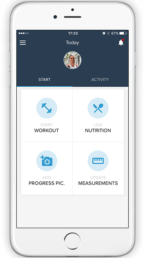
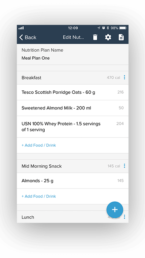
We have partnered with MyPT hub to bring the Paragon personal training approach to your phone. Now, wherever you are, you have personal training at your finger tips..
The Answer to Fitness for Business Travelers
Inevitably, just when you start to see positive physical results with your workout program, you have to head out of town for a business meeting, to meet with clients, or for a corporate retreat. We know the last thing you want to do is lose all the progress you made at the gym. We also know that maintaining fitness for business travelers can be tricky. Sure, many hotels have a small fitness facility, but how do you use it effectively enough to continue progressing toward your goals without losing ground on your fitness level? And, how do you stay on track nutritionally with all the business dinners and social gatherings that you have to attend? Not to mention the fact that there seems to be an office birthday party every single week, and sometimes they actually spring for ice cream cake.
The answer to maintaining it all while traveling is to have an online strength and fitness coach and personalized nutrition plan right on your phone. Wherever you go, you’ll have your one-on-one personal trainer there to guide you through your workouts and meals so that you don’t blow it all whenever you happen to leave town. Fitness for business travelers has never been easier!
What Makes a Good Remote Personal Training Program
When it comes time to commit to a remote personal training program, you want to make sure it’s a good fit for your personal workout style as well as your individual fitness goals. Here are a few things to look for in a program:
- One-on-one personal trainer available wherever you go
- Customized workout taking into account your fitness level, goals, and available equipment
- A professionally crafted plan that covers everything from warm-up to recovery
- Access to notes and videos explaining exactly what you should do
- A personalized nutrition plan with fully custom nutrition templates
- An easy-to-use app
When you have all of these resources at your fingertips, no matter where you are, you’ll be set up for success and well prepared for working out with the results you want waiting for you on the other end.
If you’re interested in learning more about how Paragon Strength & Fitness offers the perfect remote personal training program to help you reach your health goals, contact us today for a complimentary goal-setting session!
What Is Sports Performance Training?
Anyone who regularly participates in a sport, whether as a weekend warrior or top athlete, understands the importance of fitness and training as it relates to how well they perform. However, training is not one-size-fits-all when it comes to improving athletic performance. This is where sports performance training comes in.
Sports performance training is designed to prepare an athlete for optimum performance in a specific sport. The purpose is to work on those things that will translate into improved performance for that sport. For example, a swimmer might perform movements that strengthen their shoulder’s muscular endurance, whereas a soccer player might utilize more lower-body exercises.
It differs from typical personal training in its focus. Rather than the goal of improving general fitness, sports performance training prepares an athlete to compete in their sport of choice. Sport training mimics the movements and skills required for a particular sport, and therefore will be different from sport to sport. Facilities like Paragon Strength & Fitness in Nashville, TN, offer comprehensive sport performance training for multiple sports.
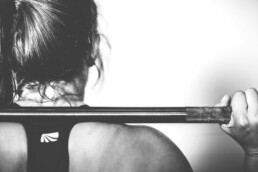
What does athletic performance mean?
Athletic performance is the execution of specific physical routines or acts by an athlete while participating in a sport or activity. It is more than just movement; physiological and psychological factors also influence athletic performance. Often, the term is used in reference to attaining specific performance objectives over a period of time, whether throughout a game, a season, or a career.
What is sports training?
Sports training guides an athlete in preparing for their sport. It typically involves physical training, like building up strength, endurance, speed, agility, and improving skill levels. Training may also include psychological preparation, such as improving self-motivation, ambition, confidence, and resilience.
How does training improve performance in sports?
Performance in any sports is a result of proficiency in the physical motions required to participate. Regular training helps an athlete practice those motions until they become second nature, and then builds up the underlying skills so an athlete can perform better. Exercises and drills, coupled with weight training, help an athlete’s body to run faster, throw farther, last longer, hit harder, jump higher, etc.
What are the 5 training principles?
The human body is extraordinary. It is remarkably adaptable, yet resistant to change at the same time. A workout regimen helps your body to push its limits for better performance. The five training principles take this into account. They are:
1. Overload
To bring about positive changes in an athlete’s body, exercise overload needs to happen. The body adapts quickly to habitual levels and stresses and is happy to keep the status quo. This means that the training load must be adjusted to go above habitual levels. The intensity or volume in an exercise can be modified, or a new exercise that tests the same muscles can be added.
2. Specificity
The body acclimates to stress quite efficiently. Specificity imposes a specific type of stress on the body repeatedly and in a variety of ways. For sport performance training, the closer the training movements parallel the specific kinds of activity in the sport, the more effective the training will be in improving performance.
3. Progression
Because the body adapts so well, in order for results to continue improving over time, the training must progressively increase in intensity or duration. If this is not done, the body will stop building strength.
4. Variation
For consistent gains in sports performance, it’s helpful to keep the body guessing (in a manner of speaking). Adjustments in a training regimen have shown to yield greater results. Variation can be achieved by switching up intensity, duration, volume, and other important aspects.
One well-known application of training variation is training in phases: conditioning, intensive sport-specific training, in-season maintenance, and off-season upkeep.
5. Consistency
The human body is the ultimate example of “use it or lose it.” When athletes stop training, the benefits of training are lost—unfortunately, typically faster than they were gained. The detraining effect can be reversed after short rest periods once training is resumed. However, extended time away from training is harder to recover from. The principle of consistency requires that athletes stay engaged in their training.
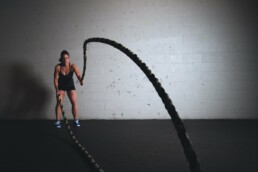
What are the 5 types of training?
At the foundational level, we train because the body makes specific changes in response to the stress placed on it. These are the five types of training associated with the typical stressors placed on the body during sports.
1. Aerobic
Aerobic training targets the aerobic energy system and the cardiovascular system. Aerobic exercise is any type of cardiovascular conditioning that increases the delivery of oxygen to the muscles, improves the removal of waste products for all energy systems, and enhances the muscles’ ability to use the aerobic energy system. Combined, these benefits allow an athlete to perform at higher workloads for longer.
2. Anaerobic
Anaerobic training develops the two anaerobic energy systems, and in the process it often improves power, strength, and speed as well. Training involves brief, intense bursts of physical activity, like sprinting or weight lifting, where the oxygen demand surpasses the supply. Anaerobic exercise is fueled by energy stored in muscles through a process called glycolysis, which also produces lactic acid. Therefore, anaerobic training improves the body’s ability to remove lactate and allows the athlete to perform higher intensity activities longer.
3. Flexibility
Flexibility training focuses on increasing a joint’s range of motion (ROM). There are two types of ROM: active and passive. Active ROM is the mobility when an athlete contracts their muscles, while passive ROM is the range when an external force, like gravity, is used. Flexibility training usually targets active ROM, because greater flexibility allows the athlete to use correct technique and helps prevent injury. Increased ROM means a joint can move through a larger angle before experiencing a strain or sprain.
4. Strength
Training intended to improve an athlete’s strength is called strength training. Exercises cause large stress on the muscle being used, which causes minor muscle tears. The body responds by increasing the size of the muscle (hypertrophy) to increase strength so that the next time the stress is experienced it won’t cause as much damage. Strength training is suited to many sports, and can help prevent injury.
5. Skills
Skills training is focused on the specific movement required for a sport. Necessary skills for basketball will be different than those for running or what an athlete needs to play football. Skills training should be individualized, because every player’s skill level will be unique. Training will often include working on technique and sport-specific drills.
The best training programs, like those found at Paragon Strength & Fitness, will incorporate all five types of training, and may offer additional services like nutrition help or online coaching.
How to train for athletic performance
The average sports participant can see improved athletic performance by incorporating some basic principles into their training. When it comes to how to train for athletic performance, keep the following guidelines in mind:
Be Consistent
Since the body quickly loses gains when you stop training, it’s important to keep a consistent training routine, even if it’s just to maintain the fitness an athlete has worked so hard to achieve.
Switch Things Up
Routines are great to keep people going to the gym, but it can be all too easy to fall into a rut. If an athlete does the same thing every week, then their performance will plateau because their body has learned how to be the most efficient at those things.
Drink More Water
It’s crucial to drink enough water for muscles to function optimally during training and when playing a sport. Dehydration will negatively impact athletic performance.
Incorporate Elements of All Training Types
Training will be more beneficial when it includes the different types of training: aerobic, anaerobic, flexibility, strength, and skills. Each plays into overall athletic performance.
How do athletes train for improved performance?
Competitive athletes understand that more goes into improved performance than just hitting the gym, although that is a major component. When they do participate in what most people think of as “training,” athletes usually approach it purposefully. They have a plan and they know why they are doing certain exercises, what they hope to gain, their performance goals, and they track their progress over time.
Nutrition also plays a large part in improving performance. There is no one-size-fits-all diet plan for athletes; everyone’s body is different. When an athlete takes the time and effort to find out how their body reacts to the nutrients they consume, they have the building blocks ready to maximize training and game-time performance.
Training for improved athletic performance includes an understanding of the importance of rest as well. Athletes will plan time for rest in addition to active training, because the body needs recovery time. Sleep is also essential for the body to repair muscles and replenish energy stores. Athletes will carve out time for proper sleep during training as well as competition season.
How does training improve performance in sports?
While all athletes will see some improved performance with any level of training vs. none at all, those who follow sports training programs typically enjoy greater gains. Training that is specifically tailored for the demands of their sport can help athletes enjoy benefits that include:
- Increased speed
- Improved conditioning
- Increased agility
- Improved balance and body awareness
- Increased strength
- Injury prevention
- Increased flexibility
- Improved endurance
- Quicker recovery
- A competitive edge
- Increased acceleration and power

What is high performance training?
High performance training is designed to improve the skills and performance of athletes participating at a high, or elite, level. High performance athletes typically compete to win prestigious competitions, not just to participate. Olympic athletes, college athletes, and those who compete in World Games would fall under the high performance category.
High performance athletes follow comprehensive training programs to achieve their full potential in the sporting arena. High performance training may include dietary and nutritional planning as well as sports performance training.
What is a sports performance coach?
A sports performance coach has knowledge in all of the related aspects of athletic performance—strength, movement, recovery, nutrition, flexibility, energy system development, etc. Their goal is to increase the level of performance, which often includes focusing on both psychological and physical preparation.
It is especially helpful if a performance coach is also highly proficient in the sports they teach, so they truly understand what athletes go through. Performance coaching is increasingly popular in professional sports because of heightened intensity and pressure on athletes to perform well.
What is the purpose of training programs in sport?
Sports training is a typical part of an athlete’s life. Training helps condition the body to perform well while participating in a sport and plays a large role in preventing injury. Almost every athlete who is more serious than the occasional “jump in on a game” player follows some type of training program.
Training programs do more than help achieve peak performance, though. Athletes gain more knowledge of their sport, learn mental resilience, and better understand the importance of having a healthy mind and body. In addition, sports training improves concentration, enhances learning abilities, and fosters better thinking and problem-solving skills. The regular physical activity with training can safeguard against depression and help reduce stress as well.
Get More From Your Training
Start reaping greater rewards from your training with the help of the best personal trainers in the Nashville area, who will tailor a plan just for you and your goals. Contact Paragon Strength & Fitness to start your life-changing journey today.
We Are Hiring!
We are hiring!
Paragon Strength and Fitness is looking to add to its team!
We are looking for:
-A person with an amazing ability to connect with other people and naturally has a positive attitude.
-Someone who is a team player and wants to work closely with others to achieve team goals.
-We are all about helping people reach their health and fitness goals, so we want someone who has a strong desire to help serve others.
Essential Functions:
-Ensure a safe and risk-free environment at all times while meeting the individual needs of the clients.
-Provide a fun, safe, clean environment for clients.
-Work one on one with members to develop a tailored fitness program.
-Demonstrate and teach members proper workout and lifting techniques.
-Provide support and encouragement to members while training them.
-Maintain all required certifications.
PT Certification (ACE, Cooper Institute, NASM, ACSM, ACSM Health/Fitness Specialist, or NSCA acceptable)
Please fill out this form and we will contact you shortly.
How Should I Warm-up Before a Workout?
A workout warm-up should be targeted to affect several things: promote an increase in core body temperature and blood flow, to increase muscle-tendon suppleness, and to enhance free coordinated movements, which, in turn, help prepare the body for exercise.(2) When performed correctly, doing a warm-up before workouts can enhance the body’s overall performance in that workout. Warm-up movements should change based on your specific workout for the day; if you have a challenging leg day scheduled, your body will respond better to activation and warm-up movements specific to your legs.
Movements specific warm-ups are also incredibly useful. Essentially, if you are going to be doing some sort of squat in your workout, you should do some variation of squatting in your warm-up. This could be a squat performed with a band around your knees to increase glute activation, or even a shallow single-leg squat to a bench to warm your quads up. The same goes for any upper body workouts. If you are doing a barbell bench in a workout, you should do some sort of horizontal pressing to warm up. This could be a regular pushup, an incline pushup or a plyometric medicine ball push to prepare your body for the given movement you are going to be performing.
Is it Important to Warm-Up Before a Workout?
Not only is it important, but studies show that dynamic warmups(think lunging, overhead reaches, high knees, lateral shuffles) increase the overall performance of the workout.(1) A strength training warm-up can prepare you for any movement you might encounter in a workout. A warm-up before a workout can also counteract your daily routine. You may find yourself waking up, sitting in the car during your commute to work, sitting at work and then sitting in the car on the way to your workout. This can cause some tight hips, legs or lower back symptoms. A dynamic warmup before you perform your workout can help get the juices flowing and help mitigate some of these symptoms.
How Long Should I Warm-Up For?
Most good workout warm-ups are around 10-15 minutes. As mentioned above, you want to MOVE during your warm-up. Studies have been conducted that compare the results of a dynamic warm-up to a static stretching warm-up. The dynamic warm-up group in each study showed increases in every testing category, while groups who performed the static stretching protocol didn’t progress and even lost percentages of several tested categories.(1)
A warmup that is 10-15 minutes long may not be feasible in your schedule. But remember, even a 5-minute dynamic warm-up is better for you than coming in completely cold to a workout. If you ask any coach, they should be able to prescribe a good warm-up before workouts for you. If you do have the ability to come in early before your session/class/private training session, make sure you take advantage of the time you have and move!
Are Warm-Up Sets Necessary?
Absolutely. Everyone regardless of training style should warm-up before workouts. Maybe you follow more of a 15,12,10 reps scheme in your workouts, or you are a weightlifter that does a standard 5×5 reps scheme for your big lifts, you absolutely need to hit some sets prior to your working sets to warm up. Warm-up sets don’t only prime your body for heavier/high rep sets, but they can give you a glimpse as to how your body feels on that given day. If you are a little more worn down or have more soreness than you expected, jumping straight into heavy sets can increase the risk for injury.
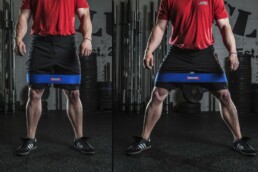
Glute activation is key to a successful leg day!
What Are Good Warm-Up Exercises?
This could be quite the extensive list if we give you all of our utilized workout warm-ups. These warm-ups can vary between clients based on age, given sport(if applicable), current injuries/imbalances or even time allotted to warm-up. Instead, we will break down our favorite workout warm-ups categorized by specific training days.
Let’s pretend you have a leg day today. Here are some lower body specific workout warm-up movements:
- A lateral banded walk, followed by a forward and backward banded walk. We prefer to use the Hip Circle bands from Mark Bell.
- Straight leg kicks – usually the length of our main gym floor area, roughly 25 yards.
- An alternating quad stretch, or a quad stretch with toe touch if you are working on balance as well.
- A lunge plus an overhead reach.
- Over/under lateral steps.
- Alternating external hip rotations.
- Quick high knees (Athletes)
- Broad jump, either single leg or bilateral (Athletes)
These movements are performed in succession with little to no rest between movements. The goal again to promote an increase in core body temperature and blood flow, to increase muscle-tendon suppleness, and to enhance free coordinated movements. These movements are wonderful if you need a specific strength training warm-up, or even if you are just warming up for a whole-body day.
You’ve just walked into the gym and it’s an upper-body day for you. Here are some upper body workout warm-up movements:
- Banded shoulder activation: This may vary based on the client, but the most common movements are banded Y’s, T’s, W’s and internal/external rotations.
- Dumbbell Internal Rotations
- Scapular Pushups or Pullups
- Band Pull-Overs
- Recline Pulls
- Cuban Press (either dumbbell or a light bar)
- Plyometric Pushups (Athletes)
Whether you are a regular gym-goer that needs a good warm-up before workouts, or you are an athlete that needs a specific strength training warm-up, feel free to contact us! We would love to chat about your specific warm-up needs and help you stay injury-free.
References https://journals.lww.com/nsca-jscr/fulltext/2008/07000/Four_Week_Dynamic_Stretching_Warm_up_Intervention.36.aspx(1) https://www.ncbi.nlm.nih.gov/pubmed/16937960(2)
